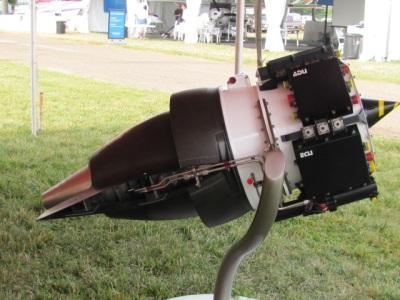Sat, Jul 28, 2012
France's Price Induction Displays Their DGEN Turbofan Mockup For The Second Year In A Row
By Anthony Liberatore
Attending AirVenture for their second consecutive year, France's Price Induction is again displaying a mockup of their DGEN 380/390 series engine. Geared towards a segment of the marketplace referred to as PLJ's (Personal Light Jets).

Integrating many advanced technologies Price Induction continues their development on the engine geared to the “PLJ” segment of the marketplace, the Personal Light Jet. The engine is twin spool turbine engine with a dry weight of 175 lbs. The company plans two versions; the DGEN 380 with 570 lbs of thrust, and the DGEN 390 with 725 lbs of Thrust. The 380 has a target Turbine Specific Fuel consumption (TSFC) of .44 at take off and a TSFC of .78 in cruise condition at 10.000 feet. With a power to weight ratio of 3.2 for the 380, it also incorporates a splitter vaned centrifugal compressor, which in conjunction with the fan gives the engine a pressure ratio of 7.92. With a by-pass ratio of 7.6, which is on the high end for a Turbofan, the 380 is also an un-mixed flow Turbofan since it's Nacelle truncates forward of the turbine nozzle
The DGEN 380 incorporates a number of advanced technologies. First, it is a geared turbofan, which puts a planetary gearbox between the low pressure spool and the fan. This is done to optimize the fan speed given design compromises which often have to be made with the low pressure turbine when it is spinning at the same RPM. This is rarefied air in the turbine engine arena given their have only been a few geared fans to ever make it into serial production. Secondly the DGEN incorporates an Integral Starter Generator, lowering the weight while making the nacelle diameter potentially smaller, because an output drive shaft and its associated hardware for connection to a generator is eliminated. When functioning in generator mode, Price Induction's Martin Vivies noted the output is 6KW, with 1.5 of that dedicated to the engine and 4.5KW's for cabin/airframe needs.
The technological innovations don't end there, as the fan and turbines form a “Blisk” ... a combination of blade and disk often machined from a single ingot which dramatically reduces parts count. The Fan material is aluminum while the turbine's material is MAR-M-247.
Looking over the display engine at AirVenture you could not help but notice the hot section and semi-pylon strut made of Carbon Fiber. In speaking with Price Induction's Christine Lloyd and Martin Vivies, they noted that the 7 test engines have accumulated 700 hrs in the test cell. With 10 years in developing the 380, Lloyd said they hope to flight-test the 380 on an aircraft within 18 months, and continue on to certification.
More News
Also: Vertical Flight Society, NBAA Maintenance Conference, GA Honored, AMT Scholarship For the first time, students from Embry-Riddle’s Daytona Beach, Florida, campus took t>[...]
Hazardous Weather Information Summary of significant meteorological information (SIGMET/WS), convective significant meteorological information (convective SIGMET/WST), urgent pilot>[...]
"The need for innovation at speed and scale is greater than ever. The X-62A VISTA is a crucial platform in our efforts to develop, test and integrate AI, as well as to establish AI>[...]
(FAA) Inspector Observed That Both Fuel Tanks Were Intact And That Only A Minimal Amount Of Fuel Remained In Each Analysis: According to the pilot, approximately 8 miles from the d>[...]
“Pyka’s Pelican Cargo is unlike any other UAS solution on the market for contested logistics. We assessed a number of leading capabilities and concluded that the Pelica>[...]
 Airborne-Flight Training 05.09.24: ERAU at AIAA, LIFT Diamond Buy, Epic A&P
Airborne-Flight Training 05.09.24: ERAU at AIAA, LIFT Diamond Buy, Epic A&P ANN's Daily Aero-Term (05.07.24): Hazardous Weather Information
ANN's Daily Aero-Term (05.07.24): Hazardous Weather Information Aero-News: Quote of the Day (05.07.24)
Aero-News: Quote of the Day (05.07.24) NTSB Final Report: Cessna 150
NTSB Final Report: Cessna 150 Aero-News: Quote of the Day (05.08.24)
Aero-News: Quote of the Day (05.08.24)



